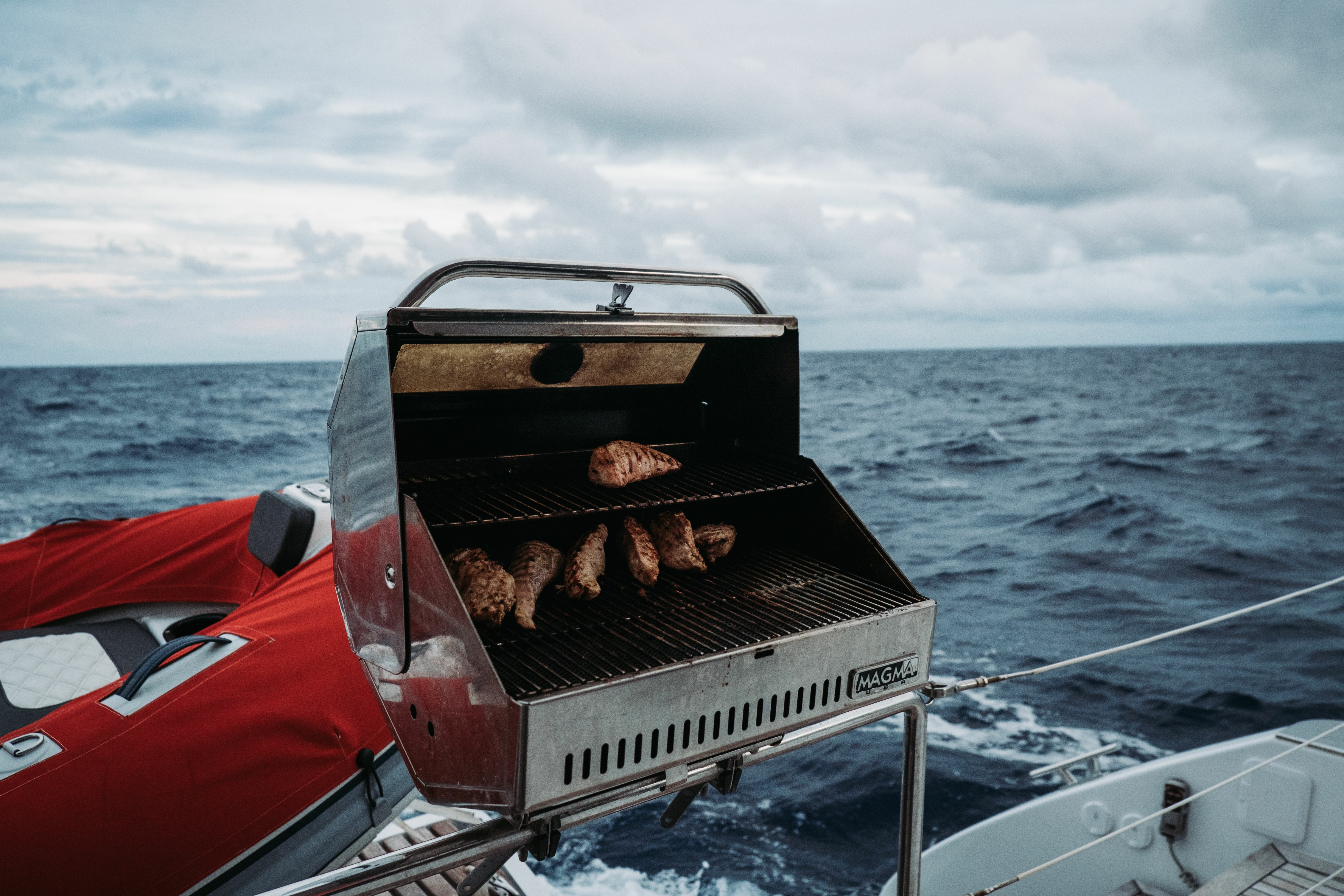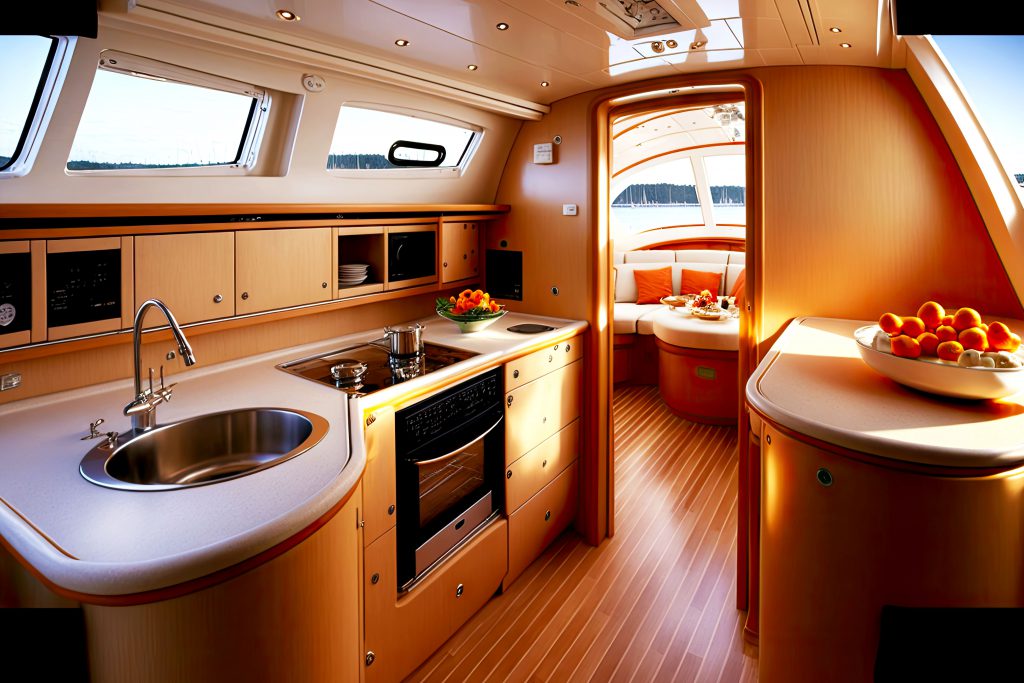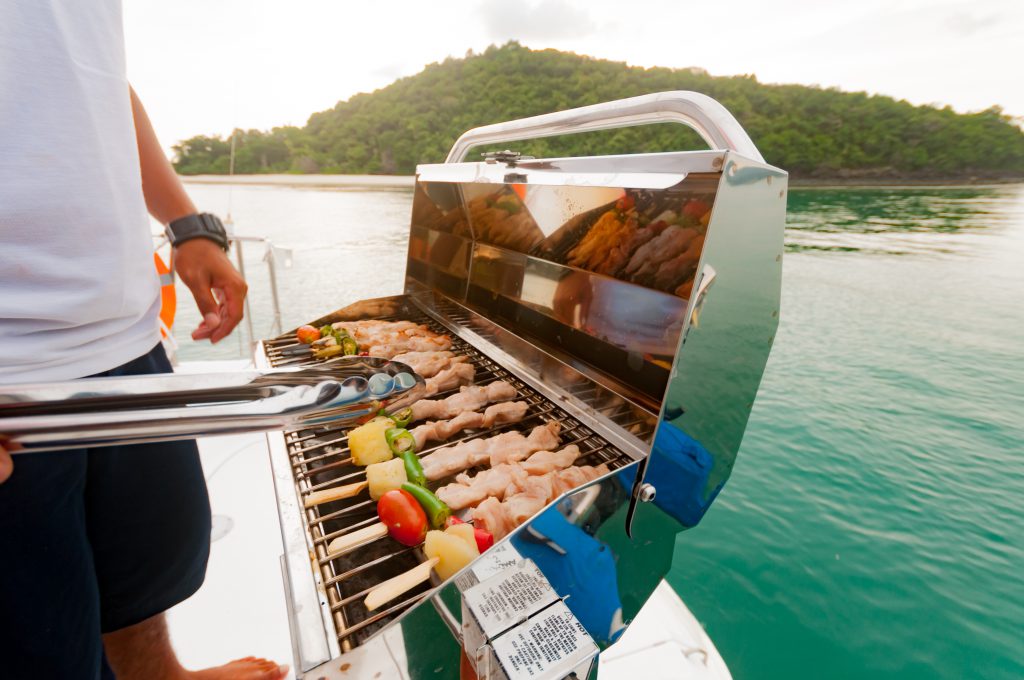Cooking on Passage, Eating at Sea
February 9th, 2023 by team

by B.J. Porter (Contributing Editor)
The other day in a Facebook group, someone asked “Do people really cook while the boat is moving? That seems dangerous.” It was a contentious topic, because admins closed comments after a while.
The answer, of course, is yes – on a multi-day passage you definitely cook offshore. It’s not practical to just not cook when you’re out of sight of land for so long. You need good nutrition, and there is absolutely nothing that restores a wet, cold and demoralized crew like a hot meal.
But let’s be safe and smart about it.
Good Passage Meals
Some wonders in the galley can make complex and memorable meals in pitching seas. The rest of us aim for tasty, easy, and nourishing. When conditions are mild, we can get fancy, but just like planning your sail changes, you work around the conditions.
One pan wonders

One pan meals can be a staple of your offshore planning, and they keep things simple and cut down on cleanup. A few “one” pan meals sometimes need a second pan to boil pasta or steam a vegetable, but planning and preparation can take care of much of that.
Some of our offshore favorites include Creamy Cajun Chicken Pasta, a copycat hamburger helper recipe, and vegetarian Cheesy Mexican Lentils, Black Beans and Rice. These are just a few examples of simple dishes which you can make in one pan and serve in a bowl, which is helpful for eating while heeling! If conditions are good, add a simple salad or vegetable and put it on a plate for a more civilized experience.
You lose the sides with one-pan meals, and most are pasta and rice centered without loads of vegetables. Try some out before you depart, and experiment. On long passages, fresh vegetables aren’t common after the first few days, so you’re working from cans for most meals.
One major benefit is these dishes do not use boiling water to cook the pasta or rice. It’s put right in with the other ingredients and cooks in the liquid, so it picks up the flavors nicely and cuts out the scalding risk.
Meal prep and planning

No matter which meals you go for, pre-cook and prepare what you can. It will help you later. Meatballs can be cooked and frozen in sauce, prepare grilled or sauteed chicken for recipes in advance, and do as much slicing and dicing as you can and store in Ziploc or vacuum bags. Just assembling and heating things up offshore is fine.
Hearty soups and stews freeze well or store in tight containers and are simple to heat. You can assemble pot pies in advance, or pan fry breaded chicken breasts for chicken parmigiana ahead of time and heat them under sauce and cheese in the oven.
The more you can cook in advance, the better, because you won’t want elaborate prep work if you’re heeling hard or bouncing around.
Things to avoid
Avoid some foods for safety or mess creation, and others may just not suit well for your crew. Our family loves spicy meals, but we found some of them didn’t settle well when the conditions were rough. This is something you learn by trial and error, unfortunately.
Don’t fry with a lot of fat. Pan frying with a little butter or oil is fine, but you don’t want hot fat sloshing around and spilling or starting grease fires. Boiling water is a scalding risk in rough conditions, so have meals planned that don’t need it in case conditions are bad.
Safety in the Galley

Safety while cooking is a genuine concern, and scalding and grease burns can be terrible off shore. With care and planning, you can cut down the chances of burning, cutting, scalding, bruising or, in some other way, harming the cook.
Brace yourself (and your pans)
Your stove should be gimbaled and have brackets for locking down your pans on the burners. If you don’t have a way to secure the pans, get one and install it. Make sure you know how to use it, and that it will stay secure with full pans on a swinging, gimbaled stove.
When gimballing the stove, put a pan on the back burner when using the front burner alone. It will help the stove stay level, otherwise it will tip forward and swing more with the unbalanced weight on the front.
Falling onto a hot stove, or falling while cooking and holding hot or sharp things is a real risk. The best offshore galleys are U-shaped or have a counter behind them for this reason. Even better ones have grab bars near the stove, which you can wrap a tether or line around to keep yourself from falling when your hands are full.
If you don’t have something behind you to lean against, definitely look into that tether around your waist. And be extra careful cooking when the stove is beneath you when heeling.
Hot grease and boiling water
Avoid deep fat. If it can slosh out of the pan while you cook, it’s not a great offshore cooking technique. A little grease and fat is unavoidable, but it’s better to pan-fry that fresh-caught mahi-mahi than trying to get fancy with a fryer. If you must use deep fat, use a high-sided pan instead of a saute or frying pan.
To avoid scalds, don’t fill pans for boiling water past halfway; use a little water as you can. Keep lots of space for the water to slosh around as the boat moves and secure that heavy pan to the stovetop. If you have to boil water to add to something, use a kettle if you have one so it won’t slosh.
Finally, dress carefully for the galley. It can be warm down below while you cook, but bare skin and scalding water and hot grease don’t mix well. People cooking in foulies aren’t doing it to stay dry, they’re doing it to avoid third-degree burns. Know where your fire blanket and extinguishers are.
Sensible is safe
It’s important to have a meal or three planned for the worst conditions, because you don’t want to be forced to cook something tough in terrible seas and weather. Even if you don’t eat that beef stew on passage because it’s wonderful weather the entire trip, having it in the freezer gives options.
Backpacking and freeze-dried food is expensive, but it lasts for years and just takes hot water from a kettle to prepare. It’s a decent fallback to get a hot meal into a tired crew in lousy weather, so consider stashing a couple of meals away.
General tips

Stay flexible
When you plan, plan the meals you will make, but don’t lock yourself into a daily must-have list. Be ready to shake it up and rearrange says. You’ll want flexibility for bad weather, but also for good things like freshly caught fish. And some days, the crew just will not feel like what’s on the plan.
Plan ahead and organize
You can measure dry ingredients for one-pan meals and combine them ahead of time. Measure the spices into a Ziploc bag for each dish and label it, and portion out pasta and rice. Keep the ingredients for a meal all in one larger bag, so you can just reach for it and dump it in instead of fooling with measuring spoons and cups. A copy of the cooking instructions in the bag isn’t a bad idea, either.
The more work you can do before you set out, the easier your cooking will be offshore.
Eat when it’s light

We learned over the years that it’s best to have the dinner meal before sunset. It’s easier to cook and serve when it’s light, and it’s nicer to eat when you can see. And we usually had work to do around sunset, like reefing or setting the sails of the evening as we got ready for the night watch. So we’d eat our big meal in the late afternoon and plan out the evening, with plenty of light left to work safely on deck while someone had a turn with the dishes.
Check with your crew
Especially if you’re sailing with adults, find out what people like and don’t like before you even start to provision. Check in after the passage too, for the next time. We thought we knew our kids’ tastes after years with them, but they voted unanimously with us that we should never make a few spicy dishes on passage again.
- Posted in Blog, Boating Tips, Cruising, Fishing, iNavX, Navigation, Sailing, Sailing Tips
- No Comments
- Tags: Boating, Boating Tips, cooking, cooking onboard, Sailing, sailing tips


Leave a Reply